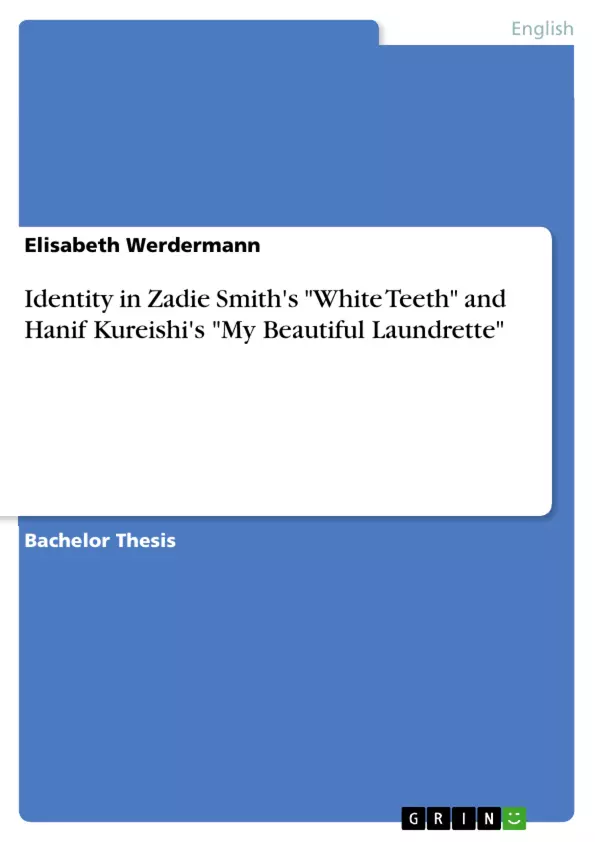Who am I? What makes me me? These are questions of daily importance to every individual human being. The question of what defines us in our per-sonality cannot be answered in a single sentence, or easily. Multiple external factors from the field of culture such as ethnicity, race, class, gender, sexual orientation or history impinge on who we are, what we identify ourselves or are identified with. According to the Oxford English Dictionary, identity defines
"Who or what a person or thing is; a distinct impression of a single person or thing presented to or perceived by others; a set of char-acteristics or a description that distinguishes a person from others."
Depending on a person’s social surroundings with all its cultural identifiers, his or her identity is shaped.
In Zadie Smith’s novel White Teeth and Hanif Kureishi’s screenplay My Beautiful Laundrette identity is presented and problematised as “In-betweenness” . Both works focus on immigrants and their children, the se-cond generation, and the difficulties they face in their daily life caused by in-betweenness. In-betweenness as a term is quite self-explanatory and depicts ambiguity on several levels like belonging, ethnicity or sexual orientation/ habits, to name only a few. This ambiguity entails the social life of the characters as well as their emotional state. In the context of belonging, it is Cherry, from My Beautiful Laundrette, who first brings the term “in-betweenness” up:
Oh God, I’m so sick of hearing about these in-betweens. People should make up their minds where they are. (Kureishi, p. 37)
By this, she labels the subliminal topic of both literary works.
With In-betweenness as a special form of identity, this research paper searches for reasons and circumstances, which make the characters in White Teeth and My Beautiful Laundrette feel in-between. On the basis of their behaviour and emotional condition against the background of their cul-tural affiliations, it will also specify the conflicts and probable advantages the state of in-betweenness entails.
Inhaltsverzeichnis (Table of Contents)
- I. Introduction
- II. The Causes of In-betweenness
- II.1. Roots and Belonging
- II.2. Preserving vs. Adapting
- II.2.1. Samad & Hussein
- II.2.2. Nasser & Ardashir
- II.2.3. Clara & Cherry
- II.3. Second Generation/ Generation Conflict
- II.3.1. Irie & Tania
- II.3.1. The Twins & Omar
- II.4. Sexual Habits
- III. Conflicts caused by In-betweenness
- III.1. Religious
- III.2. Ethical and Moral
- III.3. Violence
- IV. Positive Aspects of In-betweenness
- IV.1. Friendship
- V. Conclusion
Zielsetzung und Themenschwerpunkte (Objectives and Key Themes)
This research paper examines the concept of "in-betweenness" as a form of identity in Zadie Smith's novel "White Teeth" and Hanif Kureishi's screenplay "My Beautiful Laundrette." It investigates the causes of in-betweenness, particularly among immigrant characters and their children, and explores the resulting conflicts and potential benefits.
- The impact of immigration on identity formation
- The challenges of navigating multiple cultural identities
- Generational differences in the perception of roots and belonging
- The role of in-betweenness in shaping personal relationships and social dynamics
- The potential benefits of embracing ambiguity and in-betweenness
Zusammenfassung der Kapitel (Chapter Summaries)
- I. Introduction: This chapter introduces the concept of identity and explores how external factors like ethnicity, race, and culture influence individual identity. It introduces the theme of "in-betweenness" as a key aspect of identity in both "White Teeth" and "My Beautiful Laundrette."
- II. The Causes of In-betweenness: This chapter delves into the reasons why characters in the two works feel in-between. It discusses the challenges of navigating immigrant life in London, including the desire to preserve cultural traditions while adapting to a new environment. It also explores the role of generational conflicts, where children of immigrants grapple with their parents' cultural roots and their own experiences in London.
- II.1. Roots and Belonging: This section examines the question of belonging as a significant contributor to feelings of in-betweenness. It highlights the struggles of both the parental and second generations, who are often caught between their home countries and their adopted home.
- II.2. Preserving vs. Adapting: This section focuses on the characters' attempts to preserve their cultural traditions while adapting to life in London. It discusses the challenges of balancing different values and customs.
- II.3. Second Generation/ Generation Conflict: This section explores the conflict between the parental and second generations, who often have differing views on their cultural roots and belonging. It examines the challenges of finding a sense of identity within this conflict.
- II.4. Sexual Habits: This section examines the ways in which individual choices and behaviors, such as adultery and non-traditional relationships, can contribute to feelings of in-betweenness.
- III. Conflicts caused by In-betweenness: This chapter explores the various conflicts that arise from the characters' feelings of in-betweenness, including religious, ethical, and moral conflicts, as well as instances of violence.
- IV. Positive Aspects of In-betweenness: This chapter investigates the potential benefits of embracing in-betweenness, particularly the formation of meaningful friendships and the ability to navigate diverse perspectives.
Schlüsselwörter (Keywords)
The key terms and concepts explored in this research paper include identity, in-betweenness, immigration, multiculturalism, generational conflict, cultural adaptation, belonging, and conflict resolution.
- Quote paper
- Elisabeth Werdermann (Author), 2011, Identity in Zadie Smith's "White Teeth" and Hanif Kureishi's "My Beautiful Laundrette", Munich, GRIN Verlag, https://www.grin.com/document/172369



